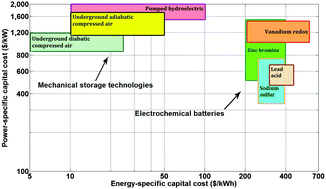How much bulk energy storage is needed to decarbonize electricity?†
Abstract
High cost and technical immaturity of bulk (multi-hour) electricity storage (BES) systems are often cited as major hurdles to increasing the penetration of intermittent renewables. We use a simple model to assess the economics of BES under carbon emissions constraints. Size and dispatch of a green-field generation fleet is optimized to meet a variable load at a 15 minute time resolution. Electricity supply options are wind, gas turbine, BES, and a generic dispatchable-zero-carbon (DZC) source as a proxy for fossil fuel plants with carbon capture or nuclear plants. We review the cost of selected BES technologies and parameterize the performance of storage, focusing on the energy- and power-specific capital costs. We examine sensitivity of the electricity cost to storage performance under a range of emissions constraints. Availability of inexpensive BES systems in general and particularly electrochemical technologies has a small impact on the overall cost of decarbonization. Proportional reductions in capital costs of wind and DZC lower decarbonization costs far more. We find no economic justification for seasonal storage. Intermittent renewables can be used to decarbonize the electricity supply with a proportionally small requirement for BES because gas provides much of the intermittency management even when the carbon emissions intensity is cut to less than 30% of today's U.S. average. Substantial BES is required only when emissions are constrained to nearly zero and DZC is not allowed.


 Please wait while we load your content...
Please wait while we load your content...